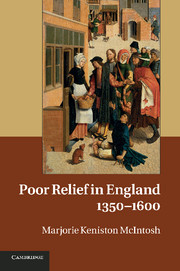Book contents
- Frontmatter
- Contents
- Acknowledgements
- Notes on conventions and online resources
- Abbreviations
- 1 Introduction
- Part I Late medieval and early Tudor patterns
- Part II Profound change during the early Reformation period
- Part III Intensified problems and altered approaches in the later sixteenth century
- 6 The burgeoning of begging, collection, and fraud
- 7 The changing nature of almshouses and hospitals
- 8 Support for the parish poor
- Part IV Responding to the problems
- Appendices included in the printed volume
6 - The burgeoning of begging, collection, and fraud
Published online by Cambridge University Press: 05 January 2012
- Frontmatter
- Contents
- Acknowledgements
- Notes on conventions and online resources
- Abbreviations
- 1 Introduction
- Part I Late medieval and early Tudor patterns
- Part II Profound change during the early Reformation period
- Part III Intensified problems and altered approaches in the later sixteenth century
- 6 The burgeoning of begging, collection, and fraud
- 7 The changing nature of almshouses and hospitals
- 8 Support for the parish poor
- Part IV Responding to the problems
- Appendices included in the printed volume
Summary
As the sixteenth century progressed and poverty intensified, begging and gathering blossomed. Rapid population rise that outpaced economic expansion increased both the breadth and the depth of need. The number of poor people seeking charitable alms for themselves was magnified by the closing of many hospitals and almshouses and the ending of support previously distributed by fraternities and chantries. Even if one’s local parish offered regular support – and some did not – that aid could seldom keep up with the demand. The ending of indulgences probably reduced the level of contributions to people collecting for individuals and institutions alike, leading to efforts to exert pressure on donors in other ways. As in the past, people requesting assistance went to private households, parish churches during services, and urban officials, where they gained at best unpredictable help. Contributions were voluntary, and there was little if any external supervision over how the income was collected or employed.
The definitions of poverty and legitimate need continued to become more complex in response to changing realities. The vagrancy statute of 1572 excluded from its punishments itinerant harvest workers, people who had been robbed while traveling, and servants whose masters had sent them away or died. A measure of 1576 eliminated the simple and familiar distinction between those capable of work and those who could not labor to support themselves, implicitly acknowledging for the first time that some able-bodied people who were willing to work could not find employment. In 1577 William Harrison described the categories of poor people in much the same terms used in London in 1552, explaining that those who qualified for relief had been affected by the various forms of “casualty” or “impotency.” Significantly, however, Harrison omitted from the earlier list the children of living poor men, a group that must now have been recognized as so numerous that attempting to assist them was impossible.
- Type
- Chapter
- Information
- Poor Relief in England, 1350–1600 , pp. 141 - 185Publisher: Cambridge University PressPrint publication year: 2011



